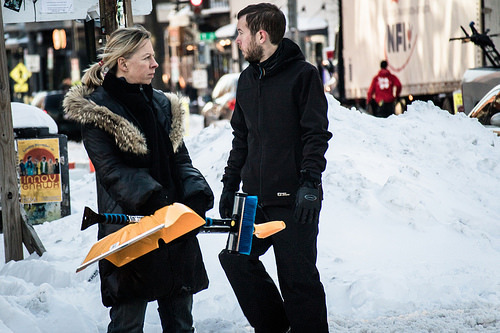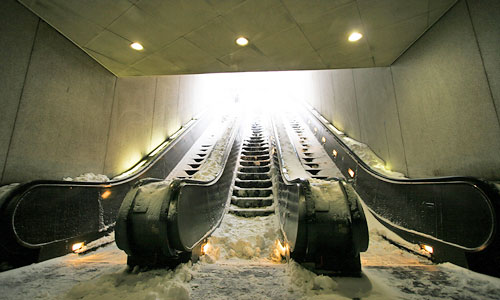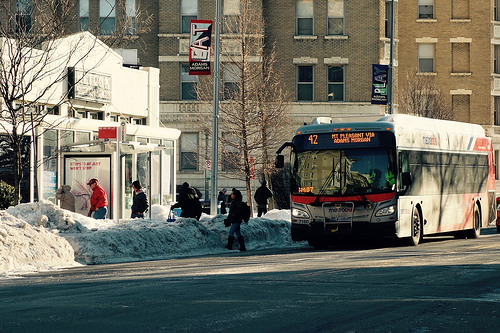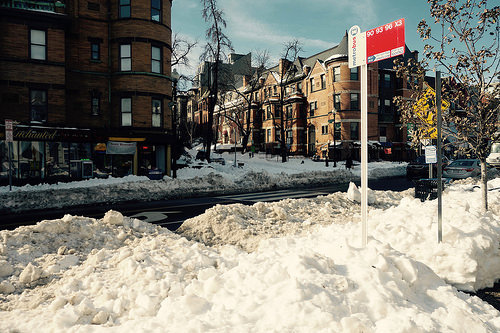How would you grade the region’s snow response?
The Kojo Nnamdi Show is asking how you would rate your government’s response to the snowtorm, your neighbors’, and your own. At 12:40, I’ll be on the show to discuss this, and I asked our contributors for their ratings.
Joe Fox gave a succinct set of ratings:
- PEPCO/Dominion/BGE: A+. Don’t forget what a disaster the last few real storms have been. Teaming up w/ plow trains & tree trimming crews meant that what problems that did pop up were fixed, and fast.
- WMATA communication: A. They were ahead of the needs, and explained what they were doing and why.
- MNCPPC [Montgomery and Prince George’s parks agency]: A. Many of the county park roads were cleared, with bonus points for sanctioning sledding hills this year.
- DC Government: B. Execution was good, but farther from downtown was rough. Bowser had some head scratcher remarks on cars vs. peds, as well as why no travel ban that were a bit hard to comprehend.
- WMATA execution: C. Is it still a surprise that when OPM gives a three hour delay, that rush hour will happen three hours later, and to set up service accordingly? Even with trains every 8+ minutes, still no 8 car trains…
- Citizens: C. These storms bring out the crazies, I noticed a lot more anger this time than in 2010. But sidewalks on private property were cleared faster than before.
- Montgomery, Prince George’s, and VDOT (handling VA counties): D+. They did what they could, but were woefully overmatched. Clumsy declarations of victory and broken data trackers brought up comparisons with PEPCO of days gone by.
- National Park Service: F. [See below.]
Contributors’ views varied, but overall, there was a good amount of consensus. Here are some key points and ratings, broken down by agency.
The National Park Service
The Park Service controls a lot of downtown parks and major trails around the region, but does very little on snow clearance. Contributors unanimously agreed it flunked the storm.
- David Cranor: “The Park Service deserves a very low grade. The Mount Vernon Trail is one of the only ones that was not plowed (thought I don’t know about the Rock Creek Park Trail). Sidewalks along NPS property were untouched. I realize they’re budget limited, but something needs to be done.”
- Neil Flanagan wrote back on Monday: “On my walk to work, through downtown to Georgetown, most government sidewalks were walkable (if not clear), with the exception of NPS.”
WMATA
Kristy Cartier: WMATA gets an “A” for communication.
Abigail Zenner: I agree with Kristy about WMATA. Our ANC has battled with WMATA about better explanation on bus route changes. I was irritated they went to severe snow routes Friday morning, hours before the storm was due. BUT, they were very clear about when and where service would be restored and it was exactly as they said, at least in Glover Park.
Dan Malouff: WMATA I think was OK but a bit too gun-shy on closing everything early, and hasn’t clearly communicated some stuff about reopening. For example, it’s understandable that some buses have to go on detour, but Metro seems to have no system in place to let riders know if their bus is detouring or not.
Mathew Friedman: I rode the G2 to work Thursday morning for the first time since last Wednesday. It doesn’t run from the “moderate” snow plan on up. Neither does the G8, which is a major route running down Rhode Island Avenue. From my neck of the woods, those are the only 2 bus lines that run downtown and for a full week, neither was running. I can at least walk 5 blocks to Shaw Metro if I need to, but for folks further out, that’s not an option. I would think that taking so long to bring these bus routes and many others back online must leave a lot of people stranded.
- Steven Yates: WMATA’s response was…mixed. Trying to shelter the trains was maybe a good theory, but the execution was obviously not great. Would it have been better to run the trains underground on Saturday instead? I’m inclined to say no, just because you probably don’t want to be encouraging people to be out and about. The running of trains for free on Monday was certainly a nice gesture.
- Travis Maiers: Metro is still operating at reduced service levels. They are apparently still short railcars due to the blizzard. I give them high marks for communicating their storm plan and being realistic on when service could be resumed, but I feel by now, 5 days later, they should be back at full service. Their plan to shut down the system for safety and to store railcars underground was prudent, but I’m not sure it was executed as well as it could have been.
- Svet Neov: I think WMATA did pretty well, since almost everything was running on Tuesday. At my stop (Grosvenor) they did a great job cleaning the sidewalks — those were done wayyy before the parking lot was.
DC
- Abigail Zenner: I thought they did a great job all things considered. Even northern cities have trouble with storms of this size. I grade them a B+ or A-. The poor rhetoric notwithstanding, DC did well. I thought that many District agencies did a good job communicating on social media and through emails to ANCs. My ANC colleagues would then send information to our lists. [The Department of General Services] promised to clear areas around DCPS schools by midnight Monday and Tuesday morning, the sidewalks all the way around Stoddert Elementary was cleared including curb cuts and bus stops. I have never seen these walks cleared so fast. I did also tweet at DCPS, Stoddert, DPR, and DGS.
- Steve Seelig: From a cycling perspective in DC, it was great. I rode from Friendship to downtown on both Monday and Tuesday, and because only part of the roadways were plowed, there was plenty of room in the curb lanes to ride where a car could not fit. As for biking infrastucture plowing: an A+ for the Capital Crescent Trail -plowed from Bethesda to Georgetown. An F for NPS on any of its trails. DDOT gets a C+ for just getting to the L Street, M Street and 15th Street bike lanes.
- Justin Lini: In DC’s Ward 7, snow removal was a bit inconsistent. Parkside and a number of other communities saw plows nearly every day of the storm. In some cases, even blocks with public housing were cleared during the storm. However, some of my neighbors in other communities didn’t see any attention at all until Monday. The Mayor’s office also did daily briefings by teleconference with the ANCs. These were useful because they communicated DC government’s plans so we could set expectations, but they also keyed us in on potential trouble. They also assigned us extra staff liaisons that could help resolve issues with trouble spots. We were able to get an important pedestrian bridge cleared by Monday evening. In the past this bridge was never consistently cleared even in routine snow events. I don’t know if the other ANCs used their liaisons, but I found mine to be a good partner. I don’t know if previous administrations employed this measure, but I thought it was very effective. Uncleared sidewalks are a huge problem in the ward. As of Tuesday many property owners, especially large apartment buildings and retail areas, did not clear sidewalks along some high volume corridors like Minnesota Ave NE. In some cases contractors had blocked sidewalks or intentionally used them to store piles of snow. Many crosswalks are also plowed over. The decision not to enforce sidewalk clearing laws on these properties until late was a big mistake that shouldn’t be repeated.
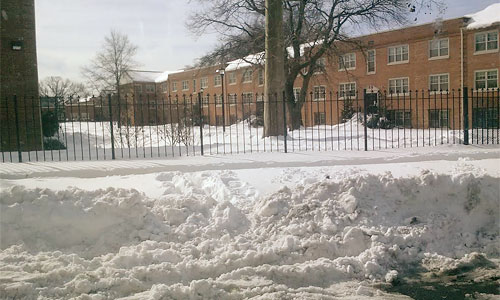
Mayfair Mansions, Ward 7, on Tuesday. Photo by Justin Lini.
- Steven Yates: I can’t really speak for other jurisdictions, but in my time here, I’ve been mostly impressed with how well DC handles large amounts of snow, given that these sorts of storms don’t happen that often (oddly, smaller amounts of snow they seem to do less well with). This storm has been no exception. The street I live in (which is by no means a major street) was at least passable a few hours after the snow ended.
Alexandria & Arlington
- Ned Russell: Alexandria streets were far worse [than in DC] both for cars and pedestrians, not to mention the DASH bus service did not run even on a limited schedule to serve rush hour on Tuesday. Sidewalks across the station that peds need to use to access Braddock Road were not cleared until this morning.
- Svet Neov: The only complaints, other than slow sidewalk cleanup, I’ve heard is dead end or small streets in Arlington which didn’t get plowed until [Tuesday] night.

King Street Metro. Photo by Justin Henry.
Montgomery, Prince George’s, and Fairfax
- Ben Ross: “I grade MoCo an A- on street clearing but an F on sidewalks. Our businesses, at least in Bethesda, did very well on sidewalks, much better than in past big snowstorms. [But] 27 hours after it has finished opening the roads to cars, the county has announced, it will begin accepting complaints about unshoveled sidewalks.begin accepting complaints about unshoveled sidewalks 27 hours after it finishes opening roads to cars. Ike Leggett announced “common sense” enforcement of the snow shoveling law. In my mind, common sense means that if you have shoveled out your driveway, you should have shoveled the sidewalk.
- Kristy Cartier: In Fairfax County, the roads had at least one lane Tuesday so I’d give them a B+ (only because there are disappearing lanes). For sidewalks, I would give a D. One person was walking on Rte. 50 near Rte. 28 and two people were standing on Reston Pkwy Wednesday morning waiting for the bus. I hope that the addition of the Silver Line stations improves Fairfax County’s response to clearing at least some of the sidewalks.
- Matt Johnson: I didn’t have any trouble [Wednesday] morning. But [in the] afternoon, I had to go to an appointment in the city, and drove to Glenmont. On my way from Glenmont to the ICC, I discovered that the 3 northbound lanes are essentially functioning as 1. The curb lane never appeared, except for the dashes periodically peeking out from the edge of the snow. The center lane would run for a few blocks and then suddenly, without warning, disappear, forcing drivers to swerve into the left lane, the only one left. In addition, pedestrians were walking in the lane, since the sidewalks were impassible, and unaccessible from the buses that run on Georgia. On the day after the storm, this might be acceptable. But several days later, on one of the region’s most important radial corridors, this is quite intolerable.
- Joe Fox: I’ve noticed that roads maintained by both state agencies (MD SHA and VDOT) fared the worst, by far. I’ve posted several tweets about Colesville Road this morning, which, despite having the ability to reverse lanes, has gone from 3 lanes to one the last two days, wreaking havoc in the neighborhoods, and with a slew of bus lines. To me, the fact that county/local roads/sidewalks/paths seemed to fare a lot better brings to mind the argument that counties (Montgomery, Fairfax), should follow the lead of the independent cities in their respective states and take control over their transportation infrastructure (save for perhaps interstate highways and maybe toll roads) from the state agencies, who are simply not equipped to handle local issues like intersection design, traffic signals, and snow clearing.

Photo by Aimee Custis.
Overall
- Svet Neov: Given the amount of snowfall I would give the region a B. I flew home on Monday morning after being stuck in Texas and used almost every mode of transportation in several places around the area. The airports were back up and running on Monday (as normal as possible). I flew into BWI which seemed to have no problems.
- Ned Russell: After reading the discussion and thinking about all the things that go into snow response, I give the region a B-. But there are a lot of things that could have been done better.
- Canaan Merchant: I’d give it a B-. For what we can expect of the region I think they did well. But to get an A they’re going to have actually acknowledge that people like to use sidewalks, bike facilities and transit and work towards that as well.
What grades would you give? Fill out the Kojo show’s poll and post your thoughts in the comments. And listen in at 12:40 to hear me and Petula Dvorak discuss the issue.
If you’re reading this before 12:40, it’s also worth tuning in to Kojo for a segment on whether high traffic fines change behavior (they don’t), including Gabe Klein as one of the guests.

